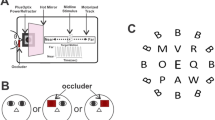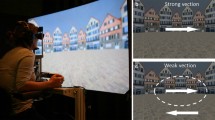Abstract
Subjects in a dark chamber exposed to angular acceleration while viewing a head-fixed target experience motion and displacement of the target relative to their body. Competing explanations of this phenomenon, known as the oculogyral illusion, have attributed it to the suppression of the vestibulo-ocular reflex (VOR) or to retinal slip. In the dark, the VOR evokes compensatory eye movements in the direction opposite to body acceleration. A head-fixed visual target will tend to suppress these eye movements. The VOR suppression hypothesis attributes the oculogyral illusion to the signals that prevent reflexive deviation of the eyes from the target thus resulting in apparent target displacement in the direction of acceleration. The retinal slip hypothesis attributes the illusion to inadequate fixation of the target with the eyes being involuntarily deviated in the direction opposite acceleration, the retinal slip being interpreted as target displacement in the direction of acceleration. Another possibility is that the illusion could arise from a change in the representation of the perceived head midline. To evaluate these three alternative hypotheses, we tested 8 subjects at 4 acceleration rates (2, 10, 20, 30°/s²) in each of three conditions: (a) fixate and point to a target light; (b) fixate to the target light and point to the head midline; (c) look straight ahead in the dark. The displacement magnitude of the oculogyral illusion was least at 2°/s² ≈ 2° and was ≈10° at the other acceleration rates. The presence of the target light significantly attenuated eye movements relative to the dark condition, but eye movements were still present at the 10, 20, and 30°/s² accelerations. The eye velocity profiles in the dark at different acceleration rates did not show a one-to-one inverse mapping to the magnitude of the oculogyral illusion at those rates. The perceived head midline was not significantly displaced at any of the acceleration rates. The oculogyral illusion thus has at least two contributing factors: the suppression of nystagmus at low acceleration rates and at higher acceleration rates, a partial suppression coupled with an integration of the drift of the eyes with respect to the fixation target.




Similar content being viewed by others
References
Angelaki DE, Klier EM, Snyder LH (2009) A vestibular sensation: probabilistic approaches to spatial perception. Neuron 64:448–461
Baker JT, Harper TM, Snyder LH (2003) Spatial memory following shifts of gaze. I. Saccades to memorized world-fixed and gaze-fixed targets. J Neurophysiol 89:2564–2576
Barnes GR (1988) Head-eye co-ordination: visual and nonvisual mechanisms of vestibulo-ocular reflex slow-phase modification. Prog Brain Res 76:319–328
Barnes GR, Eason RD (1988) Effects of visual and non-visual mechanisms on the vestibulo-ocular reflex during pseudo-random head movements in man. J Physiol 395:383–400
Bloomberg J, Jones GM, Segal B, McFarlane S, Soul J (1988) Vestibular-contingent voluntary saccades based on cognitive estimates of remembered vestibular information. Adv Otorhinolaryngol 41:71–75
Bloomberg J, Melvill Jones G, Segal B (1991) Adaptive plasticity in the gaze stabilizing synergy of slow and saccadic eye movements. Exp Brain Res 84:35–46
Blouin J, Gauthier GM, van Donkelaar P, Vercher JL (1995a) Encoding the position of a flashed visual target after passive body rotations. Neuroreport 30:1165–1168
Blouin J, Gauthier GM, Vercher JL (1995b) Failure to update the egocentric representation of the visual space through labyrinthine signal. Brain Cogn 29:1–22
Blouin J, Gauthier GM, Vercher JL (1997) Visual object localization through vestibular and neck inputs. 2: updating off-mid-sagittal-plane target positions. J Vestib Res 7:137–143
Brown RH, Imus H, Niven JI, Graybiel A (1949) The relationship between apparent displacement and motion in the oculogyral illusion. In: Mann CW, Kellum WE (eds) Research report. US Naval School of Aviation Medicine with Tulane University, Pensacola, FL, pp 1–5
Ceyte H, Cian C, Nougier V, Olivier I, Trousselard M (2007) Role of gravity-based information on the orientation and localization of the perceived body midline. Exp Brain Res 176:504–509
Chowdhury SA, Takahashi K, DeAngelis GC, Angelaki DE (2009) Does the middle temporal area carry vestibular signals related to self-motion? J Neurosci 29:12020–12030
Clark B, Graybiel A (1949) The effect of angular acceleration on sound localization (The audiogyral illusion). J Psychol 28:235–244
Clark B, Stewart JD (1969) Effects of angular acceleration on man: thresholds for the perception of rotation and the oculogyral illusion. Aerosp Med 40:952–956
Cullen KE, Rey CG, Guitton D, Galiana HL (1996) The use of system identification techniques in the analysis of oculomotor burst neuron spike traindynamic. J Comput Neurosci 3:347–368
Fluur E, Mendel L, Lagerström L (1966) Reproducibility of duration of latency time in unidirectional per-rotatory nystagmus. Acta Otolaryngol 62:118–124
Graybiel A, Hupp DI (1946) The oculogyral illusion. A form of apparent motion which may be observed following stimulation of the semicircular canals. Aviat Med 17:3–27
Graybiel A, Clark B, MacCorquodale K, Hupp DI (1946) Role of vestibular nystagmus in the visual perception of a moving target in the dark. Am J Psychol 59:259–266
Graybiel A, Kerr WA, Bartley SH (1948) Stimulus thresholds of the semi-circular canals as a function of angular acceleration. Am J Psychol 61:21–36
Guedry FE Jr (1965) Psychophysiological studies of vestibular function. Contrib Sens Physiol 14:63–135
Israël I, André-Deshays C, Charade O, Berthoz A, Popov K, Lipshits M (1993) Gaze control in microgravity. 2. Sequences of saccades toward memorized visual targets. J Vestib Res 3:345–360
Karnath HO, Reich E, Rorden C, Fetter M, Driver J (2002) The perception of body orientation after neck-proprioceptive stimulation. Effects of time and of visual cueing. Exp Brain Res 143:350–358
Lackner JR, DiZio P (2010) Audiogravic and oculogravic illusions represent a unified spatial remapping. Exp Brain Res 202:513–518
Lackner JR, Levine MS (1979) Changes in apparent body orientation and sensory localization induced by vibration of postural muscles: vibratory myesthetic illusions. Aviat Space Environ Med 50:346–354
Lester G, Morant RB (1969) The role of felt position of the head in the audiogyral illusion. Acta Psychologica (Amst) 31:375–384
Prieur JM, Bourdin C, Vercher JL, Sares F, Blouin J, Gauthier GM (2005) Accuracy of spatial localization depending on head posture in a perturbed gravitoinertial force field. Exp Brain Res 161:432–440
Quarck G, Lhuisset L, Etard O, Denise P (2009) Eye eccentricity modifies the perception of whole-body rotation. Exp Brain Res 196:295–301
Schindler I, Kerkhoff G, Karnath HO, Keller I, Goldenberg G (2002) Neck muscle vibration induces lasting recovery in spatial neglect. J Neurol Neurosurg Psychiatry 73:412–419
Seemungal BM, Gunaratne IA, Fleming IO, Gresty MA, Bronstein AM (2004) Perceptual and nystagmic thresholds of vestibular function in yaw. J Vestib Res 14:461–466
Seizova-Cajic T, Sachtler WL (2007) Adaptation of a bimodal integration stage: visual input needed during neck muscle vibration to elicit a motion aftereffect. Exp Brain Res 181:117–129
Seizova-Cajic T, Sachtler WL, Curthoys IS (2006) Eye movements cannot explain vibration-induced visual motion and motion aftereffect. Exp Brain Res 173:141–152
Takahashi K, Gu Y, May PJ, Newlands SD, DeAngelis GC, Angelaki DE (2007) Multimodal coding of three-dimensional rotation and translation in area MSTd: comparison of visual and vestibular selectivity. J Neurosci 27:9742–9756
Taylor JL, McCloskey DI (1991) Illusions of head and visual target displacement induced by vibration of neck muscles. Brain 114(Pt 2):755–759
Whiteside TCD, Graybiel A, Niven JI (1965) Visual illusions of movement. Brain 88:193–219
Acknowledgments
Research support was provided by US Airforce Office of Scientific Research grant FA9550 06 1 0102.
Author information
Authors and Affiliations
Corresponding author
Rights and permissions
About this article
Cite this article
Carriot, J., Bryan, A., DiZio, P. et al. The oculogyral illusion: retinal and oculomotor factors. Exp Brain Res 209, 415–423 (2011). https://doi.org/10.1007/s00221-011-2567-5
Received:
Accepted:
Published:
Issue Date:
DOI: https://doi.org/10.1007/s00221-011-2567-5




